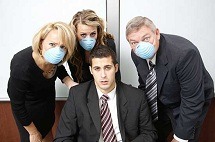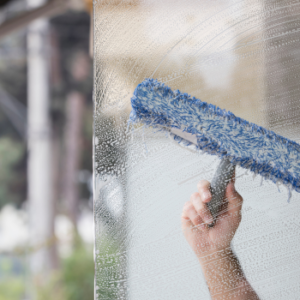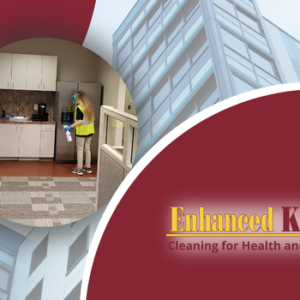Cough, cough…sniff, sniff…sneeze, sneeze…touch a doorknob and cough again!
According to recent CDC reports, the flu virus has reached a widespread status across the U.S.
With employees coming down with flu-like symptoms left and right, many companies are rethinking their strategy on whether to keep sick employees isolated, or to send them home to prevent a flu outbreak.
On top of this, many companies are seeking to educate their employees on proper hygiene techniques, along with procedures to clean, disinfect, and sanitize surfaces to prevent the spread of the flu virus.
I’m sick – should I go to work or stay home?
The 2012-2013 flu season resulted in an astonishing $8.5 billion dollars in lost wages from companies across the nation!
The last thing a company needs at the start of a new year is lackluster productivity among employees. If an employee is sick or is persistent on coming into the office, the best thing a company can do is send that employee home.
One sick employee is much better than five or ten, and will have less of an impact on lost wages and productivity levels.
How can I prevent the spread of the flu virus?
The best way to prevent the spread of the flu virus is to obtain a seasonal vaccine. The CDC website provides several options and resources you can use.
Another way to prevent the spread of the flu virus is by practicing proper hygiene techniques. While it may sound simple, many people don’t practice proper hygiene techniques to prevent the spread of germs, especially at the office. One way to combat this is to educate your employees with visual signage posted in high traffic areas, similar to what we have below:
Wash your hands with soap and water on a frequent basis. As the CDC states, “washing hands with soap and water is the best way to reduce the number of microbes on them in most situations. If soap and water are not available, use an alcohol-based hand sanitizer that contains at least 60% alcohol. Alcohol-based hand sanitizers can quickly reduce the number of microbes on hands in some situations, but sanitizers do not eliminate all types of germs.”
Avoid frequent hand contact with your face… According to a 2013 ABC News report, “The average person touches his or her face about 18 times per hour – giving the virus a path to the lungs.” You can dramatically lower your chances of catching the flu virus by simply cutting down on the number of times you touch your face.
Cover your nose and mouth when sneezing or coughing. Use tissue to cover your nose and mouth. If tissue is not available then use your arm or the end of your interior elbow to cover your mouth versus your hand.
Reduce the amount of your exposure with high-touch items. Refrigerators, door knobs, light switches, water fountains, and microwaves are just a few of the high-touch areas in your office. Try to minimize your touching of these areas to lower your chances of catching the flu-virus.
Do I clean, disinfect or sanitize?
“Studies have shown that the influenza virus can survive on environmental surfaces and can infect a person up to 2-8 hours after being deposited on the surface.” – U.S. Department of Health and Human Services
Before recommending a proper regimen to kill and prevent the spread of the flu virus, first it makes sense to clarify what it means to clean, disinfect, and sanitize.
Clean – With cleaning you are using soap (or a detergent) and water to remove germs. Cleaning doesn’t necessarily kill germs, but it can lower the risk of spreading an infection by attempting to remove them through the cleaning process.
Disinfect – Disinfecting uses chemicals to kill germs on surfaces. Using a disinfectant is not the same as cleaning (just like cleaning is not the same as disinfecting). If a product is labeled as “disinfectant only” then federal law requires surfaces to be cleaned first before applying a disinfectant. Also, when using a disinfectant make sure to read the label carefully to determine how long the solution needs to be on the surface before removing.
Note: When using bleach as a disinfectant, make sure to dilute the solution and comply with state or local regulations. A recommended dilution is 1 part bleach to 10 parts of water (or 1 oz. of bleach and 9 oz. of water).
Sanitize – A recent How to Clean Anything article provides an excellent description on the sanitization process. From the article:
“Being that flu viruses are fairly fragile, a standard cleaning and disinfecting practice may be sufficient to kill and prevent the spread of an outbreak. As per the CDC, “special cleaning and disinfecting processes, including wiping down walls and ceilings, frequently using room air deodorizers, and fumigating are not necessary or recommended. These processes can irritate eyes, noses, throats, and skin; aggravate asthma; and cause other serious side effects.”
With 2014 in full-swing companies need a healthy and productive workforce to meet mission critical deadlines. If an employee displays flu-like symptoms then it is best to send that employee home before he or she infects more of your staff.
To prevent the spread of the flu virus make sure to educate your staff on the importance of receiving a seasonal flu vaccine, along proper hygiene techniques to practice in or around the office. Also, be sure to use a proper regimen to clean, disinfect and sanitize your office to lower your risk of a flu outbreak.
Want to determine a flu virus trend in your area? Google provides a free flu chart that highlights trends across cities and states in the U.S. http://www.google.org/flutrends/us/#cities
Mister Kleen is a leading provider of contract cleaning services to Commercial and High Security facilities since 1976. Our primary service area is the DC Metro region. We also provide a variety of interior and exterior specialty services.






